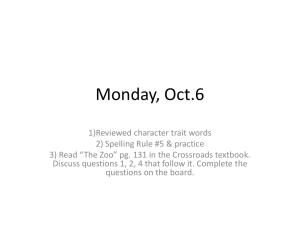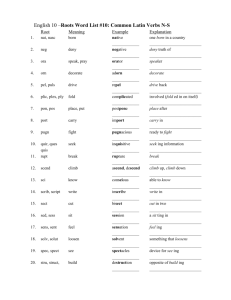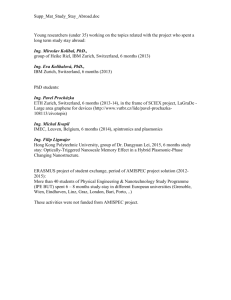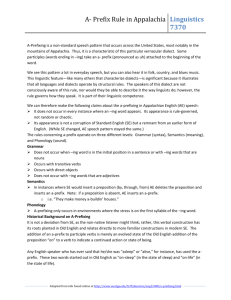Two English Inflectional Morphemes Borrowed into Advisor: Dr. Elizabeth Riddle
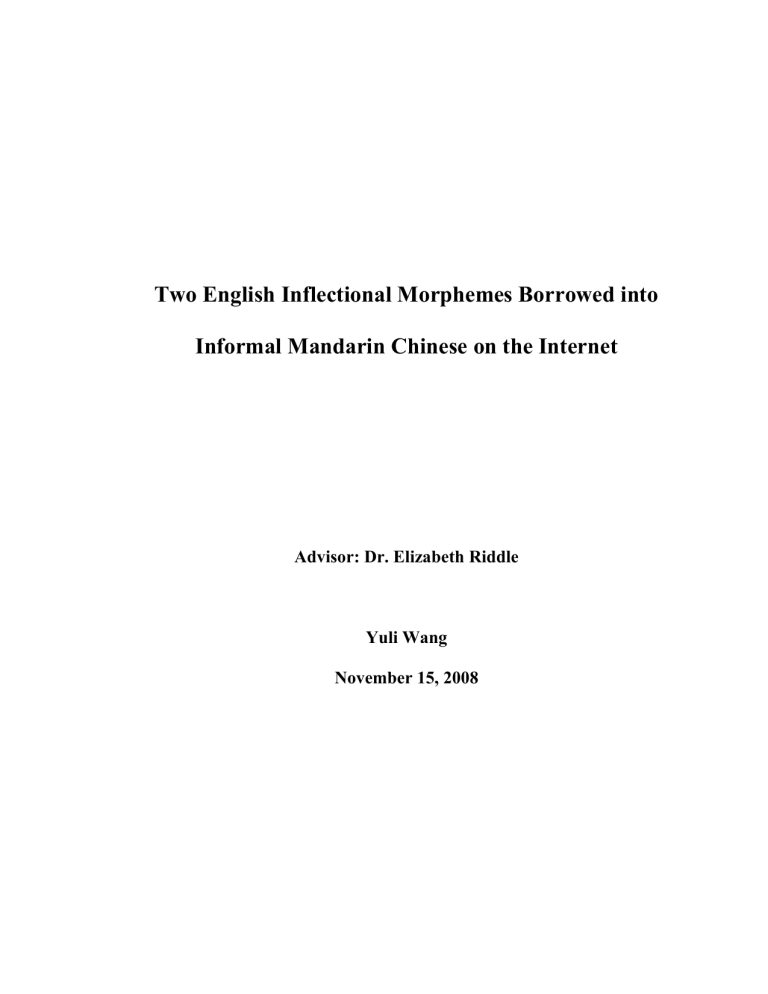
Two English Inflectional Morphemes Borrowed into
Informal Mandarin Chinese on the Internet
Advisor: Dr. Elizabeth Riddle
Yuli Wang
November 15, 2008
1. Introduction
Much of the literature on borrowing in the field of contact linguistics has been focused on lexical borrowing, while structural borrowing is still a frontline subject for which empirical studies are greatly needed. There is much disagreement about the constraints on structural borrowing. Field (2002) states a Principle of System
Incompatibility ―Any form or form-meaning set is borrowable from a donor language if it conforms to the morphological possibilities of the recipient language with regard to morphological structure.‖(p.41) He asserts that for isolating, analytic languages, there is no possibility of borrowing agglutinating affixes from agglutinating, synthetic language.
(Field, p. 40) Not as absolute as Field, Winford (2003) concludes that, ―The greater the congruence between morphological structures across languages in contact, the greater the ease of borrowing‖ (Winford, p. 93).
Mandarin Chinese, like all other varieties of modern Chinese, is an analytic language. It depends on syntax—word order and other aspects of sentence structure— rather than morphology, to indicate grammatical meaning. In other words, Chinese doesn‘t have inflectional morphemes marking tense, voice, gender, or number. However, as China deepens its interactions with western countries and as English language learning become more and more emphasized in China. English is influencing Mandarin Chinese to an unprecedented extent. More and more loanwords are flooding into Chinese and even
1
English inflectional morphemes, such as present participle –ing and past tense marker – ed, have begun to appear at the end of VPs in informal written Chinese, particularly on the internet, as in:
1. 我在做作业 ing wo zai zuo zuoye ing
I IMP do homework ing
I am doing my homework.
2. 我吃饭 ed. wo chi fan ed
I eat rice ed.
I had dinner.
I had dinner.
This phenomenon seems to sharply contradict Field‘s Principle of System
Incompatibility. So far the studies on borrowing from English to Chinese have primarily focused on lexical borrowing. There has been no study on this newly-emerging intriguing phenomenon of structural borrowing.
In this paper, I investigate a particular instance of such borrowing, namely the
English inflectional morpheme – ing as used in informal written Mandarin Chinese, based on data collected from Chinese webpages. I will first briefly introduce current theories on structural borrowing, and then discuss the English inflectional borrowings appearing in my data. I argue that the borrowed – ing in Chinese on the internet serves a replacement of Chinese imperfective particle
中 zhong , and that it does not contradict Field‘s Principle of System Incompatibility. I will also discuss the characteristics and functions of – ing in the Chinese context, and argue that there are particular social motivations for its use in
Chinese.
2
2. Methodology
The data was collected from Chinese websites, using Google as the search engine, with ing and webpages in Chinese as the key words. I saved the first 200 tokens of
Chinese phrases plus – ing of the long list as my data. I also saved the contexts where they appear. In this paper whenever I cite Chinese, I first type the Chinese character(s) and then the Romanized Pinyin in italic font. I give Chinese characters of the samples because my research target is online written text. Showing how the tokens are represented in the original text gives a clearer picture of this interesting linguistic innovation on the internet.
3. Literature Review
3.1. Structural Borrowing
It has been claimed that direct borrowing of inflectional morphology can occur when the languages in contact are close in typology.
Thomason and Kaufman (1988) state that
―one linguistic factor seems to be relevant for predicting how much, and what kind of, interference will occur in a borrowing situation: typological distance…in slight to moderate borrowing, source-language features that fit well typologically with functionally analogous features in the borrowing language tend to be borrowed first.‖(p. 72)
Varela and Feliu (2001) studied two different types of borrowing: a case of structural borrowing, illustrated by Spanish N+Vsuf
N compounds, e.g. publicontratante
3
‗publicity contractor‘ and a case of semantic extension, illustrated by the prefix co- adjoined to agentive nouns and imposing a hierarchical meaning, e.g. copiloto ‗copilot‘(backup pilot). They both indicate that ―(1) the change in order of compounds and the semantic extension of co have a similar initial motivation: ‗language contact‘ plus the social prestige of the English language…(2) in both cases the regularization of the change is favored by an internal cause. More precisely, both phenomena show a change, internally induced, that is ultimately based on analogy.‖(Varela, 2001, p. 96) This is a typical case of structural borrowing happening between languages close in typology.
Field (2002) claims that ―all content items are borrowable from one language to another as are grammatical morphemes (free or bound) that can fill slots typically occupied by elements of the borrowing (recipient) language (irrespective of their meanings).‖ (p. 41) Thus for an isolating, analytic language, there is no possibility for it to borrow agglutinating affixes from agglutinating, synthetic languages; it is also impossible for an agglutinating, synthetic language to borrow fusional affixes from fusional, synthetic languages. Field restates the Principle of System Incompatibility as follows:
―No Form or form-meaning set is borrowable from a donor language if it does not conform to the morphological possibilities of the recipient language with regard to morpheme types.‖ (p. 41)
Winford (2003) also stresses typological closeness as a key condition for structural borrowing to happen. He says ―when there is both functional and structural congruence between morphological elements, even highly bound morphemes can be transferred…In cases involving contact between less closely related languages, typological similarities or
4
congruence in certain subsystems of the grammar can also favor structural borrowing‖
(p. 93). He summarizes four constraints on morphological borrowing:
―1. The greater the congruence between morphological structures across languages in contact, the greater the ease of borrowing.
2. The greater the degree of transparency of a morpheme, the greater the likelihood of its diffusion. By contrast, the more opaque (complex, bound, phonologically reduced) a morpheme is, the less likely it is to be borrowed.
3. The existence of gaps in the morphemic inventory of a recipient language facilitates the importation of new morphemes and functional categories from a source language.
4.
The lack of a functional category in a source language may lead to loss of a similar category in a recipient language.‖
(Winford, 2003, p. 93-96)
Heine and Kuteva (2005) differentiate structural borrowing from contact-induced grammaticalization. The former is direct morphemic diffusion, that is, the borrowing of from-meaning unites, and the latter is indirect morphosyntactic diffusion, that is, replication not involving a transfer of form-meaning units. They point out that the two are not mutually exclusive, and that ―indirect diffusion is more likely to lead to ‗gap filling‘ while direct diffusion tends to give rise to what appears to be coexistence‖ (p. 249)
What‘s more, ―indirect diffusion preceded direct diffusion in time, and while most cases of the former are completed changes, the majority of the latter are ongoing and marginalized.‖(p. 249)
3.2. English Borrowings in Mandarin Chinese
Since China adopted the ―open-door policy‖ in 1978, communications between
Chinese and western people have dramatically intensified. Consequently, the contacts between Mandarin Chinese and English have been increasing. Kang (1999) describes the spread of English in China:
5
―Nowadays Chinese people can hardly avoid seeing or hearing English in daily life.
In most cities, when we take a bus or underground train we hear the stop announcement in both Chinese and English…when we start reading newspapers or magazines, English words and expressions appear in the headlines, in the contents, and sometimes in the articles proper.‖(p. 46-57)
Although interaction between English and Chinese has been increasing, Zuo (2005) points out that the Chinese lexicon is still more homogeneous than that of European languages. He cites Pasierbsky‘s (1989, p. 92-93) comparison of the English version and
Chinese version of Karl Marx‘s definitions of Arbeiskraft (labor power) in Das Kapital.
Showing that in the English version there is a large number of loanwords of Latin/French origin, while in the Chinese version the definitions exclusively use native roots. (Zuo,
2005, p. 284)
However, evidence shows English words have entered the Chinese vocabulary in ever increasing numbers. A survey conducted by Kang (1999) shows that, according to the Dictionary of New Words and Expressions ( 1989), post-1978 (the year China started reforms and open-up policy), the number of loanwords in Chinese is 3.4% of the total vocabulary. By contrast, in the 30 previous years the number of loanwords in circulation was no more than 0.75%. (Zuo, 2005, p. 284) Since the survey only covers the period till
1989, I am sure many more loanwords have come into Chinese ever since, and their number seems to be increasing.
So far, almost all studies on contact-induced change from English to Chinese focus on the phenomenon of lexical borrowing. According to theories of structural borrowing, it is next to impossible for the Chinese language to borrow grammatical morphemes from
European languages. Moreover, since Chinese culture has been very influential in Asia, it
6
also has comparatively fewer lexical borrowings from neighboring languages, let alone grammatical items.
Because of its unique character writing system, the way Chinese borrows English lexical items is very different from the way other European languages borrow from each other. Zuo points out that,
―In comparison with many other languages Chinese has an unusual capacity for creating neologisms and assimilating loan words. This capacity is evidenced in the tendency to keep outer structure of the lexical units, i.e. the form of Chinese characters, which, as time goes by, makes loanwords indistinguishable from autochthonous forms. Thus the foreign origin of loanwords is obscured by the writing system.‖(Zuo, 2005, p. 285)
Of course, this is only true of the written, not the spoken language.
Zhou and Jiang (2004) also express a similar view, ―Researchers of borrowings in
Chinese have been using different typologies. This is probably because Chinese uses an ideographic writing system with what we call hanzi (‗characters‘), which makes it impossible to borrow words directly from alphabetic languages such as English and
French.‖ (p. 285)
Zuo further introduces three major methods of dealing with foreign loans: semantic transposition, phonetic transcription and direct borrowing of foreign letter words.
1.
Semantic transposition consists of the use of indigenous morphemes to capture the most salient features of the foreign concept. One example is piano, which in Korea and in Japan is adopted as a direct loanwords, but is semantically transposed in
Chinese, which uses 钢琴 gangqin (―steel musical instrument‖). The two characters together makes a word meaning ―a kind of musical instrument made of steel‖.
7
2.
Phonetic transcription consists of borrowing directly from the source language, using
Chinese characters to approximate the source language pronunciation. For example,
沙发 shafa ( ―sofa‖) .
3.
A new borrowing pattern, consisting of direct borrowing of foreign letter words, has been emerging during the past few decades.
(Zuo, p. 285-286)
However, Zuo‘s categorization is not very satisfactory. It ignores two very important types of foreign borrowing in Chinese— loan translation and phonemicsemantic loan .
Loan translation is a word or phrase borrowed from another language by literal, word-for-word translation. For example, ―hotdog‖ is in Mandarin Chinese is 热狗 re
(― hot‖) gou (―dog‖), ―notebook computer‖ is 笔记本电脑 bijiben (―notebook‖) diannao
(―computer‖) and ―blue states‖ (the states of the USA whose residents predominantly vote for Democratic Party presidential candidates) is 蓝州 lan (―blue‖) zhou (―state‖).
Phonemic-semantic loan means a word borrowed phonemically and part semantically (Zhou & Jiang, 2004, p. 49). Zuckermann (2003) also pays great attention to this phenomenon. He calls it PSM— phono-semantic matching , which he claims ―is a pervasive form of lexical borrowing, apparent in Israeli, Turkish, Chinese, Japanese,
Yiddish, Hebrew, Arabic creoles and many other languages.‖(p. 290) One example in this category is the Chinese loan word for ―vitamin‖
— 维他命 weitaming . The three Chinese characters literally mean ―preserve+his+life‖. The morphemes compounded reflect the attributes of vitamins, and also largely preserve the pronunciation of the English word.
8
Another example is 奔腾 benteng , the nativised ―Pentium‖. The two Chinese characters are one existing Chinese word meaning ―gallop; rise, soar‖. It indicates the fast processing speed of this series of CPU, and its pronunciation is somewhat close to
―Pentium‖.
Research on English borrowings into Chinese has focused on lexical borrowing.
This is natural, since structural borrowing is more likely to occur where there is intense language contact, and tends to occur when languages in contact are typologically close.
Here the two languages—Chinese and English are in neither of these two situations.
Although English has entered daily life in China, Chinese is still the primary language for communication, and the majority of China‘s population is still monolingual in Chinese.
Also, Chinese and English are typologically distant from each other.
3.3. Aspect System of Mandarin Chinese
The Chinese aspect system is very different from that of English. It has attracted linguists‘ attention for quite a long time, but most studies focus on particular aspect particles. According to Xiao and McKenery (2004, p. 3)
―little attention has been paid to date to the question of systematically describing the linguistic devices that the language employs to express aspectual meanings…there is no generally agreed account of the aspect system of this language, as different researchers define aspect in their own ways.‖
With regard to imperfective aspect particles in Mandarin Chinese, Li calls 在 zai and
正在 zhengzai adverbs, and zhe a particle. (2005, p. 45) Xiao and McEnery (2004) list five aspect particles, namely the durative aspect 着 – zhe, the progressive aspect: 在 zai, the inceptive aspect 起来 – qilai, the continuative aspect, 下去 xiaqu, and the zero
9
aspect—covert aspect marking. Yang and Bateman (2002, p. 2) also have a different categorization: activity-durative 在 zai, durative 着 zhe, long-durative 一直 yizhi, activity-progressive 正在 zhengzai ,正 zheng , start-and-continue起来 qilai, and continue-to-future
下去 xiaqu.
In my paper, particle will be consistently used to refer to those aspect markers in
Chinese.
4.
English Inflectional morpheme -
ing
in Chinese Found on the Internet
4.1. Background
According to Bernard Comrie (1985), tense is grammaticalised time reference.
Mandarin Chinese is a tenseless language in that it does not have grammatical marking to signal the relation between the time of the occurrence of the situation and the time that situation is brought up in speech. Interpretation replies heavily on context and/or temporal adverbials to locate time reference. Mandarin is more concerned with aspect, i.e.
―the internal temporal constituency of a situation‖. (Comrie, 1975, p. 3) It has complex aspect system and numerous aspectual particles. The sentences below show how aspect and time reference are expressed in Mandarin.
. 1. A:
一起吃晚饭吧?
yiqi chi wanfan ba?
together eat dinner participle
Shall we have dinner together?
10
B: 我吃过饭了 wo chi guo fan le
I eat PRF dinner PRF
I had dinner.
2 .我上午做了作业。 wo shangwu zuo le zuoye.
I morning do PRF homework
I did homework in the morning.
3. 我昨天在考试。
wo zuotian zai kaoshi
I yesterday IMP take exam
I was taking exam yesterday.
4 . 我在考试。
wo zai kaoshi
I IMP take exam
I am (was) taking exam.
过 guo, 了 le
,在
zai are common Chinese particles indicating aspect. They are not inflectional morphemes, since they are not bound to verbs. In example 1, we know A‘s action of having dinner is completed because of the perfective aspect particle le, and that it happened in the past because of the context provided by A‘s utterance. In examples 2 and 3, the temporal adverbials 上午 shangwu (in the morning) and 昨天 zuotian
(yesterday) indicate past time reference; le marks the completion of the action in example
2, and zai indicates that the action is in progress in 3. In example 4, we are not sure whether the action in process is happening now or was happening in the past, because there is no context or tense adverb provided.
In the past, Chinese was not as open to external influences as European languages were. Its aspect system is probably primarily the result of internal development.
However, in this new age of globalization, due to the rapid development of modern
11
communications, Mandarin Chinese, as well as Chinese culture in general, has been impacted by external forces to an unprecedented degree. It borrows only lexical items.
Nowadays Chinese young people have adopted an alternative way to express imperfective aspect in Chinese on the internet—adding –ing .
4.2. Findings
As mentioned above, I took the first 200 tokens of Chinese phrases plus – ing appearing on google as my corpus. These tokens can be divided into three categories: non-stative VP+ ing, stative VP+ ing and NP + ing. Although it seems the borrowed – ing should undoubtedly follow VPs, in my data there are ten NPs + ing, and the rest are VPs
+ ing I divided the VPs into non-stative VPs and stative VPs. The chart below shows the number and percentage of the three types of grammatical phrases with
– ing.
Non-Stative VP + ing Stative VP + ing NP + ing
Number Percentage Number Percentage Number Percentage
149
Total: 200
74.5% 41 20.5% 10 5%
Table 1.
4.3. Non-Stative VPs + ing
It is not surprising non-stative VPs + ing form the largest group of my data. In
English, most of the time ing is used with action verbs. Below are some tokens of VP + ing from my data. For each example, the first line is the Chinese characters, the second line the Romanized pinyin, the third line word-to word translation, and the fourth line the
English equivalent expression.
12
5. 轻松地享受春天 ing
qingsong de xiangshou chuntian ing
light-hearted enjoy spring ing
Enjoying the spring light-heartedly
6. 小杰打盹 ING
Xiaojie dadun ing
Xiaojie take a nap ing
Xiaojie is taking a nap
7. 岳晓琳老师打造模特 ING
Yue Xiaolin laoshi dazao mote ing
Yue Xiaolin teacher train model ing
Teacher Yue Xiaolin is training models.
8. 大家开始下载 ing
Dajia kaishi xiazai ing
Everybody start download ing
Everybody is starting to download.
9. 寻找史上最完美的面膜 ing~~~ xunzhao shishang zui wanmei de mianmo look in the history most perfect ATTR facial mask
Looking for the most perfect facial mask in history
10. 呼和浩特电视台招聘主持人 ING
Huhehaote dianshi tai zhaopin zhuchiren ing
Huhehaote TV station seek MC ing
Huhehaote TV station is seeking MCs.
11. 一只耳朵聆雨 ing yizhi erduo ling yu ing one ear listen rain ing
Listening to the rain with one ear
12. 求助 ing 求助 ing !
qiu zhu ing qiu zhu ing help ing help ing
Asking for help! Asking for help!
The -ing marker is quite common in informal Chinese on the internet now. It is obvious that the young Chinese netizens have borrowed the grammatical meaning of
–ing
13
along with its form. It indicates the continuousness of the action. In fact, in most cases when using – ing, Chinese people omit the original Chinese imperfective aspect particles, such as zai, zhengzai, or zhong.
. Of the 200 tokens, only three use both Chinese imperfective aspect particle and – ing. All the others only use – ing. We can see from example 5 to 12 there is no aspect particle in them. It is clearly
–ing
is borrowed to replace the Chinese particles to indicate the continuousness of action. The only exceptions are the following three tokens in the group of dynamic VPs + ing :
13.
咔咔网产品促销进行中 ing kaka wang chanpin cuxiao jingxing zhong ing kaka website product promotion progress IMP ing
Promoting sale on Kaka website
14. 格调婚照――发送 ing 中
Gediao hun zhao----fasong ing zhong
Gediao wedding photo send ing IMP
Sending Gediao wedding photos
15. 福州夜景美图持续征集中 ing…
Fuzhou ye jing mei tu chixu zhengji zhong ing
Fuzhou evening view beautiful picture continuously collect ing
Continuously collecting beautiful pictures of Fuzhou evening views
In examples 13 to 15, it is unnecessary to use ing , since 中 zhong is used to indicate the aspect. The English equivalents of the three tokens would show no difference if
–ing was not used in them. It looks like – ing is added simply to attract people‘s attention to the content of these sentences.
正在 zhengzai, 在 zai, and 着 zhe are the three Chinese imperfective aspect particles most frequently discussed in the literature. Yang and Bateman (2002, p. 2) mention ―the secondary types of unmarked durative aspect‖, that is, the complex durative aspect combined by at least two simple primary aspect participles, but in their list, 在 zai/
14
正在 zhengzai + VP + 中 zhong are not mentioned. Actually, no study has mentioned this structure so far. Below are some sentences with this structure.
16a. 妈妈在做晚饭中
mama zai zuo wanfan zhong
Mom IMP do dinner IMP
Mom is/was cooking dinner
17a. 他还在焦急地等待中。
ta hai zai jiaoji de dengdai zhong
he still IMP anxious ADV wait IMP
He is/was still waiting anxiously.
18a. 孩子们正在紧张地排练中。
haizi men zhengzai jinzhang de pailian zhong
child PL IMP nervous ADV rehearse IMP
The Children are rehearsing nervously.
In the English equivalents of the above three sentences, either present tense or past tense makes sense since neither a temporal adverbial nor context is provided. The
Chinese character 中 zhong, when used together with 在 zai or 正在 zhengzai, is put right after the VP, indicating being in the middle of something. The two particles combine to form an unmarked durative aspect.
However, in informal written or oral Mandarin, when using this structure, 在 zai or
正在 zhengzai preceding VP are often omitted , and only 中 zhong following VP is used.
This abbreviated structure is frequently seen in posts on the internet. Below are the same sentences with only 中 zhong as the imperfective aspect particle.
16b. 妈妈做晚饭中
mama zuo wanfan zhong
Mom do dinner IMP
Mom is/was cooking dinner.
15
17b. 他焦急地等待中。
ta jiaoji de dengdai zhong
he anxious adverb particle wait IMP
He is/was still waiting anxiously.
18b. 孩子们紧张地排练中。
haizi men jinzhang de pailian zhong
child PL nervous ADV rehearse IMP
The children are/were rehearsing nervously.
I believe the borrowed
–ing in Mandarin Chinese is a replacement for the structure of the abbreviated VP +
中 zhong structure, not only because the VP + -ing also mark the durative aspect, but also because – ing and 中 zhong have the same position in the sentence.
4.4. The Position of – ing
If the VP consists of only one intransitive verb, -ing immediately follows the verb; but if the VP includes not only a verb but also other components, such as a noun as the object following the verb, -ing follows immediately after the whole VP instead of the verb. Examples 6 and 8 are illustrations of the first case, and 5, 7, 9 and 11 are examples of the second case. Even when the NP following the verb is a long and complex one, like in 9, ing still follows the whole VP instead of the verb. This is quite different from
– ing
‘s position in English. As we know, ing is a suffix immediately following verb. It can never be separated from the verb.
Below are three sentences with 中 zhong as the imperfective aspect particle found on the internet. In my corpus of VPs + ing, there are sentences with the same VPs as in
16
the 中 zhong sentences. These are put in pairs below, with each a the 中 zhong case and each b the – ing case. The equivalent VPs in each pair are marked in bold.
19a. 演艺明星捐款名单(不断更新中)
yanyi mingxing juankuan mingdan (buduan gengxin zhong )
entertainment star donation list (constantly update IMP)
The donation list of entertainment stars (constantly updating)
19b. 超多绿色单文件软件!持续更新 ING
chao duo lvse dan wenjian ruanjian! chixu gengxin ing
super many green single file software constantly update ing
So much green single-file software! Constantly being updated.
20a. 刚辞职,在厦门找工作中
gang cizhi, zai Xiamen zhao gongzuo zhong
just resign in Xiamen look for job IMP
I just resigned, and am looking for a job in Xiamen.
20b.
找工作 ing
zhao gongzuo ing
look for job ing
Looking for a job
21a. 期待中…… qidai zhong
expect IMP
Expecting……
21b. 期待 ing
qidai ing
expect ing
Expecting
It is clear that from sentences 19-21, 中 zhong in a and –ing in b mean the same thing, and are interchangeable. They strongly support the claim that – ing is a replacement for the Chinese imperfective aspect particle 中 zhong on the internet.
When 中 zhong is used to mark imperfective aspect, if the verb is a transitive verb, and the object in VP is relatively long, the order of verb and noun phrase in the VP is
17
often reversed, and zhong still put at the end of the VP. In this case zhong immediately follows the verb. See the examples below:
22.
人生计划思考中
rensheng jihua sikao zhong
life plan think IMP
Thinking about my life plan
23. 北京 2008 奥运会筹备中
Beijing 2008 aoyunhui choubei zhong
Beijing 2008 Olympics prepare IMP
Beijing is preparing for the 2008 Olympics.
In my data there are more tokens with the alternative VP order—object + verb + ing than verb + object + ing order. See table 2 below.
VPs with transitive verbs
Verb+ noun
Number Percentage
VPs with intransitive verbs
Noun + verb
Number Percentage Number Percentage
21 14% 26 17% 102 69%
Total: 149
Table 2.
Table 2 shows that slightly more than two thirds of the verbs in non-stative VPs are intransitive verbs. For those VPs with transitive verbs, 21, or 13% are in verb + NP order, and 26, or 17% are in NP + verb order. Following are two examples of the reversed NP + verb order from my data.
24. 绝望主妇第四季更新 ing juewang zhufu disi ji gengxin ing desperate housewife the fourth season update ing
Updating Desperate Housewives Season 4.
18
25 . 2007 微软最有价值专家申请 ing
2007 weiruan zui you jiazhi zhuanjia shenqing ing
2007 Microsoft most have value expect apply ing
Applying for The 2007 Most Valuable Microsoft Expert
In examples 24 and 25,
–ing
can be replaced with
中 zhong without changing the two sentences‘ meanings.
Therefore, I suggest that – ing is being used in Chinese as a replacement for 在 zai/
正在 zhengzai +VP+ 中 zhong, or the abbreviated VP + 中 zhong structure. It preserves the grammatical meaning of English -ing , but is not an inseparable suffix on a verb stem anymore. In fact, it is unacceptable to insert – ing between the verb and object if the internal order of VP is verb + object. Below is an example of the unacceptable order:
* 更新 ing 绝望主妇第四季
gengxin ing juewang zhufu disi ji
update ing desperate housewife fourth season
4.5. The Structure of Stative Verb + ing
The structure ―subject (optional) + predicative adjective‖ is very common in
Mandarin Chinese. It is generally agreed that Chinese adjectives are actually stative verbs because they can function as predicates. As we know, in English a copula or any other link verb (e.g. get, turn) must be used between subject and the predicative adjective. But in Chinese, the copula 是 shi is often absent. The predicative structure is put right after the subject and functions like a verb. The following two sentences are examples of the use of Chinese stative verbs.
19
26.
她年轻漂亮。 ta nianqing piaoliang she young pretty
She is young and pretty.
27.
小强很能干。
Xiaoqiang hen nenggan
Xiaoqiang very capable
Xiaoqiang is very capable.
In my data there are 41 tokens of stative VPs + ing. Below are a few examples.
28.
忙碌 ing manglu ing busy ing
I am busy.
29. 美丽 ing
meili ing
beautiful ing
I am beautiful.
30. 欣喜 ing xinxi ing joyful ing
Being joyful
31.
母亲节到底送什么啊?郁闷 ing muqin jie daodi song shenme ya? yumen ing mother day on earth give what MOD frustrated
What on earth should I give for Mother‘s day? I am frustrated
Example 29 is the title of an online cosmetic shop. Examples 28 and 30 are independent phrases without any other component attached to them. In 31 the predicative adjective + ing is still independent from the preceding question, although it is closely related to the question in meaning. Mandarin Chinese is a pro-drop language, and omission of subject pronoun is very common, especially in informal Chinese. The logical subjects of the above four stative verbs + ing are the narrators themselves.
20
In Mandarin Chinese, the stative VPs + 中 zhong structure is also very common. In examples 28-31,
–ing
and zhong can be used interchangeably without any change in meaning. Below are some examples of stative verbs + 中 zhong found on the internet.
32.
姐妹们,帮帮忙, 郁闷中。
jiemei men, bang bang mang, yumen zhong
sister PL help help frustrated IMP
Sisters, help me! I am frustrated.
33. 我的爱犬牺牲了 …….
极度难过中
wode ai quan xisheng le………jidu nanguo zhong
my dear puppy sacrifice PRF extreme sad IMP
My dear puppy died. I am extremely sad.
Stative VPs +
中 zhong and stative VPs + ing are similar in structure and share the same grammatical meaning. This is further evidence that
–ing
is a replacement for the
Chinese imperfective aspect particle 中 zhong.
4.6. Noun Phrase + ing
My data also includes 10 tokens consisting of a NP +
–ing
, which look somewhat odd to me. Below are some examples:
34 .
活力 ing huoli ing
energy ing
Energy
35. 我的学车纪录 ing wode xue che jilu ing my learn car record ing
My record of driving practice
21
36. 大学生活 ing daxue shenghuo ing college life ing
College life
In 35 it might look like there is a verb 学 xue (learn) in the phrase, but it is not a VP in that 学车 xue che (learn to drive) is an attributive of the noun 记录 jilu (record). The
English equivalent is ―my record of driving practice‖. These noun phrases with
–ing
are ambiguous in meaning and make translation somewhat difficult. Understanding these phrases has to be based on context. For instance, example 36 is the title of a virtual blog community. The description of the community can be translated as follows: ―Let‘s search with our eyes those idols who have ever touched our hearts, and recall those songs that have ever moved us‖. ―College life‖ is not mentioned explicitly, but it can be conferred that the college days of those people are over, and the theme is to recall those good old days. Therefore, example 36 can be understood as ―recalling college life‖. Without context it is hard to guess out the meanings of these NP + ing.
NP+ ing is the marked structure of – ing in online informal Chinese. It is much rarer than the structure of VPs + ing.
4.7. English Past Tense Morpheme ed in Chinese Found on the Internet
As mentioned above, Mandarin Chinese is an aspect language. It is primarily concerned with the progress of an action. It is generally agreed that there are no tense markers in
Mandarin Chinese, except for the future tense. Tsang (1981) argues that in Chinese 会
22
hui
―will, can‖ and 要 yao
―will, want‖ have become future tense markers, similar to will in English. Please see the examples below:
37. 我明天要去打蓝球。
wo mingtian yao qu da lanqiu
I tomorrow will go play basketball
I will go play basketball tomorrow.
38. 我夏天会回来。
wo xiatian hui huilai
I summer will return
I will come back in the summer.
There are no such tense markers for other time references in Mandarin Chinese. In most cases, optional tense adverbs and context indicate the time reference. But recently the English past tense marker
–ed
has begun to appear in informal Mandarin Chinese on the internet, though it seems very rare so far. Below are the only three tokens of Chinese
VP+ ed in my data.
39. 起床 ed~ 洗漱 ed~ 吃饭 ed~ 打球 ed~ 看书 ed~ 上网 ed~ 吃饭 ed~ 工作 ed~ 看球 ed~
上网 ed~ 去中关村 ed~ 上网 ed~ 吃火锅 ed~ 上网 ing~will 锻炼 ~will 早点歇啦!明
还有活呐!!! qichuang ed , xishu ed, chifan ed , daqiu ed , kanshu ed , shangwang ed , get up ed, brush teeth ed, eat meal ed, play ball ed read book ed surf online ed, chifan ed gongzuo ed , kanqiu ed, shangwang ed, qu zhongguan cun ed, eat meal ed, work ed watch ball game ed surf online ed, go Zhongguan Village ed shangwang ed , chi huoguo ed , shangwang ing, will duanlian, surf online ed eat hotpot ed surf online ing will do exercise, will zaodian xie la!! ming haiyou huo na will earlier rest MOD tomorrow have work MOD
I got up, brushed my teeth, had breakfast, played basketball, read book, surfed online, worked, watched ball game, went to Zhongguan Village, surfed online, had hotpot, now surfing online, will do exercise, and will go to bed earlier! I have to work tomorrow!
23
40 . 这种自己顶自己的糗事,俺老人家以前做 ed ,现在做 ing ,以后会 will 做~!
Zhe zhong ziji ding ziji de qiushi, an laorenjia yiqian zuo ed , xianzai zuo ing , this kind of self support self of thing, I old man before do ed, now do ing yihou hui will zuo later will do
I replied to my own posts. I did this kind of embarrassing thing before, am doing it right now, and will do it in the future!
41.
做 ed 爱做的事交 ed 配交的人,还是圆满了。嗯,我喜欢这里,喜欢这里的人 zuo ed ai zuo de shi jiao ed pei jiao de ren, haishi yuanman le did love do
‘ s thing made deserve make
‘ s people, still satisfactory PRF en, wo xihuan zheli, xihuan zheli de ren yes I like here like here ATTR people
Having done things that I liked to do, and made friends that deserved to be my friends, I feel satisfactory. I like here, I like people here.
It is obvious that the past tense marker
–ed
is not commonly used and accepted online by young Chinese. Unlike
–ing which is frequently used in independent short phrases or incomplete clauses, all the VP +ed in my data are found in complete sentences, and they all have obviously contrasting time reference in the same sentence.
Examples 39 and 40 are quite interesting. All the VPs in them are marked for tense and aspect in an ―English‖ way. Both sentences use
–ed, or the auxiliary verb will and
–ing to emphasize the changing of time. Although example 41 only has
–ed
following the VPs, the two VPs+ed are obviously in contrast with the tense in the main clause.
I suggest that this difference between the use of – ed and the use of – ing is largely related to their different degrees of acceptance. Since
–ing is so pervasive, and has become publicly accepted on the internet, it is a good way to focus people‘s attention.
But – ed , on the other hand, is not yet widely accepted. Therefore using it causes the risk
24
of confusion. For this reason, it does not appear in fragments, but rather where the time reference is clear. It also has the function of drawing attention, and its user may feel it also quite fashionable, like
–ing.
There is also another difference between borrowed –ing and borrowed –ed. As discussed above, -ing never appears immediately after the verb if the verb has an object following it. As for –ed, example 38 shows the same pattern: ed follows the whole VP instead of the verb, unless the verb does not have an object after it. But there are some – ed positioned between the verb and the object, as shown in example 40. In examples 39 and 41, where the verbs are intransitive, ed follows the verbs.
Why Chinese permits
–ed
to interrupt the VO structure is not clear yet. One reason may be that the borrowed – ing is widely accepted by young people, and it is used very much like the Chinese imperfect aspect particle 中 zhong , but – ed is not that wide-spread, so some people follow the English rule of placement to avoid confusion.
5. The Functions of –
ing
in Informal Chinese on the Internet
It is obvious the Chinese netizens have borrowed the meaning of – ing along with its form. The
–ing ending indicates the continuousness of the action. The semantic similarity of VP + ing and VP+ 中 zhong make it very likely that the former is an alternative way to express the latter . But why has Chinese borrowed this inflectional morpheme from
English and replace the Chinese imperfective aspect particle with it?
25
Winford (2003) points out that borrowings under distant contact seem to be motivated by two considerations, namely the demand to fill gaps in the recipient language and considerations of fashion or prestige. As for – ing in the Chinese context, I think the latter is the major motivation for its adoption and rapid spread.
Western culture has been admired by Chinese young people for quite a while.
American TV shows, movies and pop music are very popular in China. In those young people‘s eyes, American culture has a relatively prestigious status. American pop culture is a target for imitation. Being ―cool‖ and ―trendy‖ is a common goal for young Chinese.
Under this trend, playing with English inflectional morphemes in Chinese is a way for them to appear fashionable. The – ing morpheme is incompatible with the Chinese language system, so they adapt it, making it closer to Chinese grammatical usage.
But in contrast to native Chinese particles, ing has the function of drawing people‘s attention to the content. That is why in examples 13, 14 and 15, although they have
Chinese particles to mark the aspect, ing is still occurred at the end of the phrases.
I categorize my tokens by the contexts where they appear. The results further prove that the primary function of the borrowed – ing is to draw people‘s attention.
26
Titles
Titles of posts in public forums
Titles of announcements or news by websites
Titles of blog entries
Contents
Titles of blogs or personal homepages
Contents of posts in public forums
Contents of blog entries
Others (names of books or other products)
Table 3.
Number
Percentage
Number
Percentage
130
65%
14
7%
Number 24
Percentage 12.4%
Number
Percentage
10
5%
Number
Percentage
Number
Percentage
Number
7
3.5%
5
2.5%
10
Percentage 5%
Total number found in titles: 178, 89% of all the tokens
Total number found in contents: 12, 6% of all the tokens
Total number found in others: 10: 5% of all tokens
178 of 200, or 89% of the tokens appear in titles. Of the 178 tokens the titles of posts in public forums form the largest group. Only 12 tokens, or 6% of the total occur in the contents of posts. These statistics strongly support the claim that the borrowed – ing serves the function of drawing people‘s attention to those posts.
The past tense morpheme –ed occurs less frequently than –ing , and also started to appear more recently. In my data, the earliest – ing appears in 2004, but all the 4 – ed tokens appear in 2008. Although at this point it can not be asserted that no
–ed
was used before 2008, the possibility exists. Also due to small size of my – ed data, it is not clear yet whether it behaves more like an English inflectional morpheme or a Chinese grammatical particle in the Chinese context.
27
4.
Discussion
Does the borrowing of
–ing in informal Chinese on the internet contradict Field‘s
Principle of System Incompatibility? At the first sight, this seems to be the case. As an
English inflectional morpheme, ing is not compatible with Mandarin Chinese, a strongly analytic language. According to Field, it is impossible for structural borrowing to occur between two languages like English and Mandarin Chinese. So the occurrence of – ing and the emergence of
–ed
would appear to violate the Principle of System Incompatibility.
However, this is actually not the case. In my data, ing is not treated as an inflectional morpheme in Mandarin Chinese on the internet; instead, it has been adapted for use as a free morpheme analogous to other Chinese grammatical particles. In other words, although it still preserves the meaning of the English inflectional morpheme –ing, it is not an inflectional morpheme in Chinese. As for – ed, since I do not have sufficient data to test it, I can not state with certainty how it behaves, but I believe it probably does not function as an inflectional morpheme, either, given the way – ing has been reanalyzed. In sum, as far as – ing is concerned, it does not contradict Field‘s Principle of System
Incompatibility.
So far the borrowed – ing is mainly limited to written Chinese. I found only one token in oral language, in the well-known Chinese song ― 恋爱 ing‖(being in love), in which ―ing‖ is pronounced letter by letter as I, N, G. However, this is the only sample of uttered – ing in Chinese. Generally people do not use it in daily oral communication.
28
5. Conclusion
In this paper I analyzed the borrowing of the English inflectional morphemes – ing and – ed into informal Mandarin Chinese on the internet. This borrowing seems to be related to the trend toward English study among Chinese people and China‘s closer contact with English-speaking countries.
–ing
seems to have been accepted by Chinese young people on the internet, and has become very popular on Chinese websites. It preserves the semantic meaning of – ing in English, but is not an inflectional bound morpheme in Mandarin Chinese. Instead it is much more like a Chinese grammatical particle, and in my view, it is a substitute for the structure of VP+ 中 zhong . Therefore, its borrowing does not contradict Field‘s Principle of System Incompatibility, since it does not act as an inflectional morpheme in Chinese. The borrowing of – ed is probably induced by that of – ing , but it appears to be rare at this time.
I conclude that the prevalence of
–ing in Mandarin Chinese on the internet indicates the prestige of American culture and the fever for learning English in China. It stresses the continuousness of the action or state, and serves the function of drawing people‘s attention to those posts, especially as it appears most often in titles of posts on the internet.
29
Abbreviation List
ADV: Adverbial marker
ATTR. Attributive marker
IMP: Imperfective aspect particle
MOD: Modal particle
PL: Plural marker
PRF: Perfective aspect particle
30
References
Comrie, Bernard. 1976. Aspect: An Introduction to the Study of Verbal Aspect and
Related Problems.
Cambridge: Cambridge University Press.
Comrie, Bernard. 1985. Tense.
Cambridge: Cambridge University Press.
Field, Fredric. 2005.―Long-term effects of CS: Clues to Structural Borrowing.‖
International Journal of Bilingualism. Vol.3, No.3 & 4, 2005, p. 341-360.
Field, Fredric. 2002. Linguistic Borrowing in Bilingual Contexts.
Amsterdam/Philadelphia: John Benjamins Publishing Company.
Heine, Bernd & Kuteva, Tania. 2005. Language Contact and Grammatical Change.
Cambridge: Cambridge University Press.
Kang, Jianxiu. 1999. ―English Everywhere in China.‖ English Today, Vol. 15, No.2, p. 46-48.
Li, Catherine. 1995. ―Aspect in English and Chinese.‖ Ohio University Working Papers in Linguistics and Language Teaching, Vol. 14, p. 41-53.
.
Li, Yen-hui Audrey. 1990. Order and Constituency in Mandarin Chinese. Dordrecht, The
Netherlands: Kluwer Academic Publishers.
Myers-Scotton, Carol.1992. ―Codeswitching as a Mechanism of Deep Borrowing,
Language Shift, and Language Death.‖ Language Death; Factual and Theoretical
Exploration with Special Reference to East Africa. New York: Mouton de Gruyter.
Pasierbsky, F. 1989. ―Adaptation Processes in Chinese: Word Formation.‖ Coulmas, F.
(ed). Language Adaptation. p. 90-103. Cambridge: Cambridge University Press.
Sanchez, Tara Savannah. 2005. ―Constraints on Structural Borrowing in a Multilingual
Contact Situation.‖ Dissertation Abstracts International, A: The Humanities and
Social Sciences , 66, 2, Aug, 574-A.
Singh, Rajendra. 2001. ―Morphological Diversity and Morphological Borrowing in South
Asia.‖ The Ye arbook of South Asian Languages and Linguistics . p. 305-320.
Thomason, Sarah Grey & Kaufman, Terrence. 1988. Language Contact, Creolization, and Genetic Linguistics. Berkeley & Los Angeles, CA: University of California
Press.
31
Tsang, Chui-lim. 1981. A Semantic Study of Modal Auxiliary Verb in Chinese.
Unpublished PhD. Dissertation. Stanford University.
Varela, Soledad & Feliu, Elena. 2003. ―Internally Motivated Structural Borrowing in
Spanish Morphology‖ in Theory, Practice, and Acquisition; papers from the 6 th
Hispanic Linguistics Symposium and the 5 th
Conference on the Acquisition of
Spanish and Portuguese. Kempchinsky, Paula & Pineros, Carlos-Eduardo [Eds],
Somerville, MA: Cascadilla, 2003, p. 83-101.
Winford, Donald. 2003. An Introduction to Contact Linguistics.
Oxford: Blackwell
Publishing Ltd.
Xiao Richard & McEnery, Tony. 2004. Aspect in Mandarin Chinese: A corpus-based study. Amsterdam/Philadelphia: John Benjamins Publishing Company.
Zhou, Chenggang & Jiang, Yayun. 2004. ―Wailaici and English Borrowings in Chinese.‖
English Today 79.
Vol. 20, No. 3, p. 45-52.
Zuckermann, Ghil‘ad. 2004. ―Language Contact and Globalisation: The Camouflaged
Influence of English on the World‘s Language—with Special Attention to
Israeli(sic) and Mandarin.‖ Cambridge Review of International Affairs, Vol. 16,
No.2, p. 287-307.
Zuo, Xiulan. 2005. ―Language Planning with Respect to English into China.‖
Terminology 11:2. p. 283
32
33


